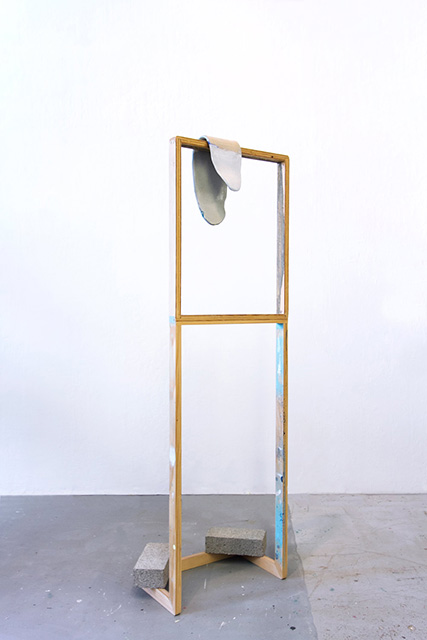WARNING: This article contains a sexually-explicit image.
Once you figure out how to pronounce it, SEXXXITECTURE begins to sound like a lifestyle blog pairing sensuous spiral staircases with trails of lingerie. While this image isn’t entirely inaccurate (and a possible avenue for future internet domination), the title refers to a cheeky group exhibition of works by Alejandro Almanza Pereda, Daniel Gerwin, Rebekah Goldstein, Roman Liška, Max Maslansky, May Wilson and Jake Ziemann at the Mission Street gallery CULT | Aimee Friberg Exhibitions.
In keeping with the traditions of interior design, the gallery’s two rooms are color-coordinated. Facing the street, it’s all cool blues and whites. In the back gallery, fleshy pinks rule. Some of the work is quite large — and there’s a lot of it — so the imposing qualities often associated with modern architecture are here transferred to paintings, dominating the arrangement of wall works and sculpture.

The first work the visitor encounters, by Max Maslansky, sets the exhibition’s sultry tone fairly explicitly. The artist paints colorful scenes culled from 1970s and ‘80s porn stills on bedsheets and pillowcases, linking his materials to a postcoital tangle of limbs and sheets, the expected result of the scenes he depicts. Interior Storybook (Queen bed) shows a woman in blue high heels and a garter belt pulling her clothes over her head for the benefit of the man seated splayed-legged before her. The setting is close and domestic, signaling that SEXXXITECTURE is more about interior than exterior spaces.
The exhibition’s sculptural work better captures the immediacy and physicality of sex. May Wilson’s tubular and droopy sculptures blend formalism and anthropomorphism. The suggestively-titled Hung1 (white) hangs from the gallery ceiling off an ordinary hardware store ratchet, a contrast to its austere pearlescent vinyl casing, stuffed tight with sand.

Just below Wilson’s gently swaying sculpture, Jake Ziemann’s wont you come down and put it down on me is a delicate wooden frame supporting a flopped ceramic oval on its top edge. All precarious balance and taut placement, Ziemann’s piece captures the tension and exhaustion of physical attraction.


